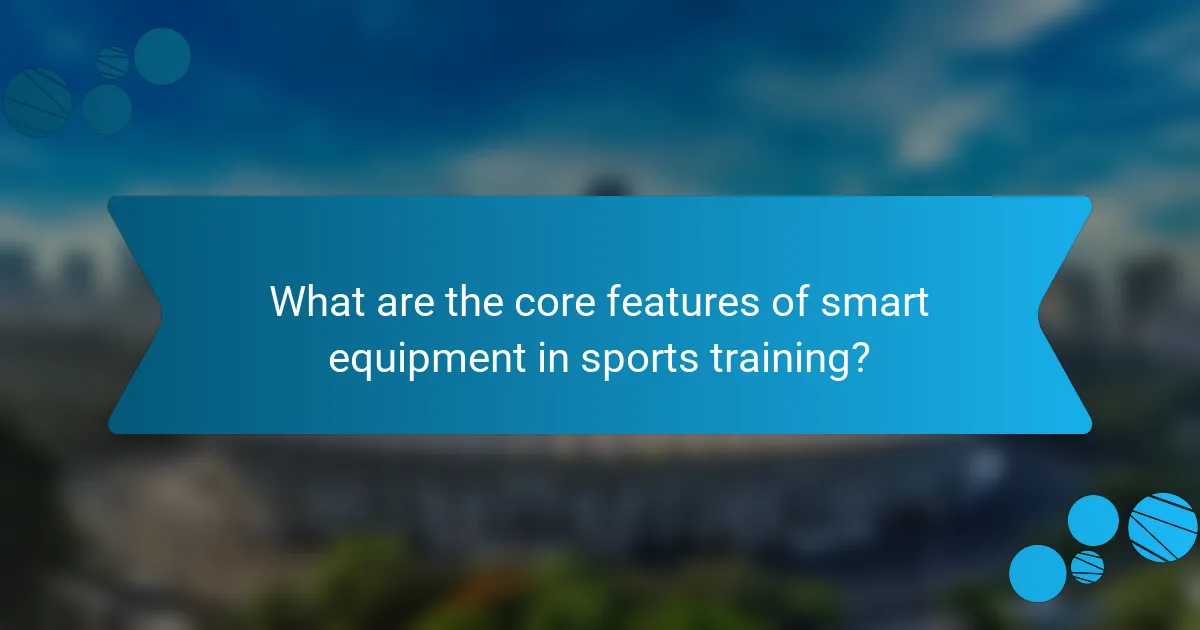Smart equipment in sports training offers significant advantages such as real-time feedback and personalised coaching. Key features include performance tracking, data analytics, and compatibility with various devices. This article explores the functionality of wearables, smart training aids, and connected fitness machines, while addressing challenges in integration and user experience. Additionally, it provides comparisons of essential attributes to help athletes select the right equipment for optimised training outcomes.

What are the core features of smart equipment in sports training?
Smart equipment in sports training features advanced technology for performance tracking, real-time feedback, and personalised training. These devices enhance training efficiency and effectiveness. Key features include connectivity, data analytics, and adaptability to various sports. For instance, smart wearables monitor heart rate and movement, while smart equipment like connected exercise machines provide tailored workouts.
How do sensors enhance performance tracking?
Sensors significantly enhance performance tracking by providing real-time data on athletes’ metrics. These advanced technologies measure variables such as speed, heart rate, and movement patterns, enabling precise assessments of performance. For instance, wearable sensors can track an athlete’s exertion levels, helping coaches tailor training regimens effectively. Furthermore, data analytics derived from these sensors can identify areas for improvement, leading to optimised training strategies. This integration of smart equipment in sports training ultimately supports enhanced athletic performance and injury prevention.
Which data analytics capabilities are essential for athletes?
Essential data analytics capabilities for athletes include performance tracking, injury prevention analysis, and personalised training insights. These capabilities enable athletes to optimise their training regimens and enhance their performance.
Performance tracking utilises wearable technology to monitor metrics like heart rate, speed, and distance, providing real-time feedback. Injury prevention analysis examines data patterns to identify risks, helping to reduce injury occurrences. Personalised training insights leverage analytics to tailor workouts based on individual strengths and weaknesses, maximising efficiency and effectiveness.
Incorporating these capabilities into training can lead to improved results and longevity in an athlete’s career.
How does connectivity impact the functionality of smart sports equipment?
Connectivity significantly enhances the functionality of smart sports equipment by enabling real-time data transmission and analysis. This integration allows athletes to monitor performance metrics, receive instant feedback, and adjust training regimens effectively. For instance, smart wearables can track heart rate and movement patterns, providing insights that improve overall training efficiency. Additionally, connectivity facilitates seamless interaction with coaching apps, ensuring that athletes can access personalised training plans and performance analytics on the go. As a result, athletes benefit from a more informed and adaptive training experience, leading to improved outcomes.

What advantages does smart equipment offer in training regimens?
Smart equipment enhances training regimens by providing precise data, personalised feedback, and real-time performance monitoring. These features lead to improved efficiency and effectiveness in workouts. Smart devices often integrate with apps, allowing users to track progress and set goals. The unique ability to analyse performance metrics helps athletes optimise their training strategies. Additionally, smart equipment can adapt to individual needs, making workouts more engaging and tailored.
How can personalised feedback improve athlete performance?
Personalised feedback enhances athlete performance by tailoring training to individual needs. Smart equipment collects data on technique, strength, and endurance, providing insights that help athletes adjust their training regimens. This targeted approach leads to improved results and reduces the risk of injury. Additionally, real-time feedback allows for immediate corrections, reinforcing learning and skill development. Athletes can track progress over time, ensuring continuous improvement and motivation.
What role does real-time data play in injury prevention?
Real-time data significantly enhances injury prevention in sports training. It enables immediate feedback on athletes’ performance, identifying potential risks before they lead to injuries. Smart equipment collects metrics like biomechanics and workload, allowing coaching staff to adjust training regimens proactively. This data-driven approach fosters safer training environments and optimises athlete health.
How does smart equipment facilitate remote coaching?
Smart equipment facilitates remote coaching by providing real-time data tracking and feedback. These devices enable coaches to monitor athletes’ performance metrics from a distance, enhancing training effectiveness. For example, smart wearables can track heart rate, movement patterns, and overall exertion levels, allowing for personalised coaching adjustments. This technology fosters better communication between coaches and athletes, ensuring that guidance is timely and relevant.

Which types of smart equipment are most popular among athletes?
Wearable devices, smart training equipment, and connected fitness machines are the most popular types of smart equipment among athletes. These tools enhance performance tracking, provide real-time feedback, and facilitate data analysis for improved training outcomes.
Wearable devices like fitness trackers and smartwatches monitor metrics such as heart rate, steps, and calories burned. Smart training equipment, including smart weights and resistance bands, adjusts resistance based on user performance. Connected fitness machines, such as smart bikes and treadmills, offer interactive workouts and virtual coaching.
The integration of technology in these devices allows athletes to personalise their training regimens, track progress over time, and optimise performance. As a result, athletes can make informed decisions based on precise data.
What distinguishes wearable technology from smart training devices?
Wearable technology focuses on tracking health metrics, while smart training devices emphasise performance improvement. Wearables, such as fitness trackers, monitor heart rate and sleep patterns. Smart training devices, like smart weights, provide feedback on form and technique. This distinction highlights their unique attributes: wearables prioritise health insights, whereas smart training devices enhance athletic performance.
How do smart balls and other equipment compare in functionality?
Smart balls and other equipment vary significantly in functionality. Smart balls provide real-time data on performance metrics, while traditional equipment lacks this capability.
| Equipment Type | Functionality | Real-time Data | Training Feedback | Connectivity |
|—————-|—————|—————-|——————-|————–|
| Smart Balls | Advanced | Yes | Yes | Yes |
| Standard Balls | Basic | No | Limited | No |
| Smart Wearables | Comprehensive | Yes | Yes | Yes |
| Traditional Gear| Minimal | No | None | No |

What unique attributes set specific smart equipment apart?
Unique attributes of smart equipment in sports training include advanced analytics, real-time feedback, and personalised coaching. These features enhance performance tracking and training efficiency. For instance, some devices offer biometric monitoring, which provides insights into an athlete’s physiological state. Additionally, connectivity with mobile apps allows for seamless integration of training data, enabling athletes to adjust their routines based on performance metrics.
How do premium brands like WHOOP and Peloton innovate in the market?
Premium brands like WHOOP and Peloton innovate by integrating advanced technology into smart equipment for sports training. WHOOP focuses on personalised health metrics, offering insights on recovery and strain through continuous heart rate monitoring. Peloton enhances user experience with interactive workouts and community engagement through live classes and leaderboards. Both brands leverage data analytics to improve performance and motivate users. Their unique attributes, like WHOOP’s strain tracking and Peloton’s gamified fitness, set them apart in a competitive market.
What are the specialised features of smart equipment for team sports?
Smart equipment for team sports features advanced tracking, real-time analytics, and enhanced communication. These tools improve performance through data-driven insights, enabling coaches and players to make informed decisions. For instance, wearable devices can monitor heart rates and movement patterns, while smart balls provide feedback on technique. Unique attributes like customisable settings allow teams to tailor equipment to specific training needs.

What challenges do users face when integrating smart equipment into their training?
Users face several challenges when integrating smart equipment into their training. Common issues include compatibility with existing systems, complexity of use, and data overload from multiple devices.
Compatibility can hinder seamless integration, as not all devices work well together. Complexity of use may discourage users, particularly if the technology requires extensive setup or understanding. Data overload can overwhelm users, making it difficult to extract actionable insights for training improvements.
These challenges can impact the effectiveness of smart equipment in enhancing athletic performance. Addressing these issues is crucial for maximising the benefits of technology in sports training.
How can data overload hinder athlete performance?
Data overload can significantly hinder athlete performance by overwhelming them with excessive information. This can lead to confusion and decreased focus during training and competition. Smart equipment, while beneficial, can contribute to this overload if not managed properly. Athletes may struggle to interpret complex data, which can impair decision-making and execution of skills. Effective data management is crucial to enhance performance rather than detract from it.
What technical issues are common with smart sports devices?
Common technical issues with smart sports devices include connectivity problems, inaccurate data tracking, battery life limitations, and software glitches. These issues can hinder performance analysis and user experience. For instance, connectivity problems may arise from weak signals or compatibility issues with other devices. Inaccurate data tracking can lead to misleading performance metrics, affecting training outcomes. Battery life limitations often restrict usage duration, while software glitches may result in unexpected device behaviour. Addressing these issues is crucial for maximising the benefits of smart equipment in sports training.

Which comparisons are crucial when selecting smart equipment?
When selecting smart equipment for sports training, crucial comparisons include functionality, compatibility, user interface, and data accuracy. These factors directly impact performance enhancement and training efficiency.
| Comparison | Functionality | Compatibility | User Interface | Data Accuracy |
|———————-|—————-|—————–|——————|—————–|
| Smart Wearables | Activity tracking, heart rate monitoring | Compatible with various devices | Intuitive app design | High precision in metrics |
| Smart Training Aids | Real-time feedback, coaching assistance | Works with multiple platforms | Easy navigation | Reliable data collection |
| Smart Equipment | Customisable settings, progress tracking | Syncs with fitness apps | User-friendly controls | Validated performance metrics |
| Smart Sensors | Motion analysis, performance insights | Integrates with training software | Clear display | Accurate movement detection |
How do price points affect the choice of smart training tools?
Price points significantly influence the selection of smart training tools. Higher-priced equipment often offers advanced features, enhanced durability, and superior technology, appealing to serious athletes. Conversely, budget-friendly options may lack some functionalities but still provide essential training benefits. Users often weigh the cost against the perceived value and features, making informed choices based on their training goals and budget constraints.
What should athletes consider when comparing brand offerings?
Athletes should evaluate smart equipment based on features, performance metrics, and brand reputation. Key considerations include compatibility with training goals, data accuracy, and user-friendly interfaces. Comparing customer reviews and expert opinions can also provide insights into product reliability and effectiveness. Additionally, assessing warranty and customer support can influence long-term satisfaction and value.

What best practices should athletes follow when using smart equipment?
Athletes should follow best practices for using smart equipment to enhance performance and safety. First, ensure proper calibration and setup to match individual metrics. Regularly update software for optimal functionality. Utilise data analytics to track progress and adjust training regimens. Prioritise consistent usage to maximise benefits and avoid injury. Lastly, maintain equipment to ensure longevity and accuracy.
How can athletes maximise the benefits of data insights?
Athletes can maximise data insights by utilising smart equipment that tracks performance metrics. This equipment offers features such as real-time feedback, personalised training programmes, and injury prevention analytics. For example, wearable devices can monitor heart rate and movement patterns, providing athletes with actionable insights to enhance their training efficiency. As a result, athletes can make informed adjustments to their routines, leading to improved performance and reduced risk of injury.
What common mistakes should be avoided in the usage of smart training devices?
Common mistakes in using smart training devices include neglecting proper calibration, overlooking software updates, and failing to set realistic goals. Users often misuse data metrics, leading to misinterpretation of performance. Additionally, not integrating devices into a comprehensive training plan can hinder effectiveness. Lastly, ignoring user manuals can result in underutilisation of features.